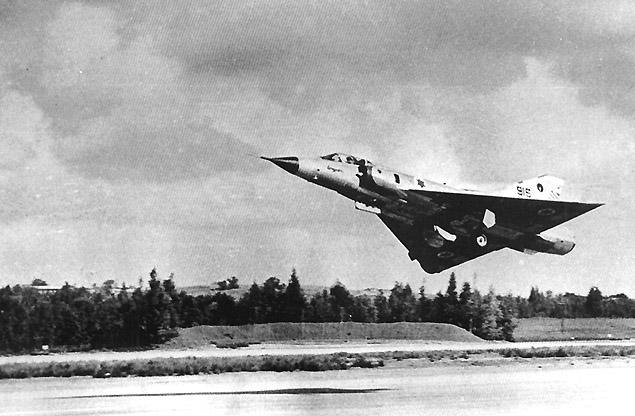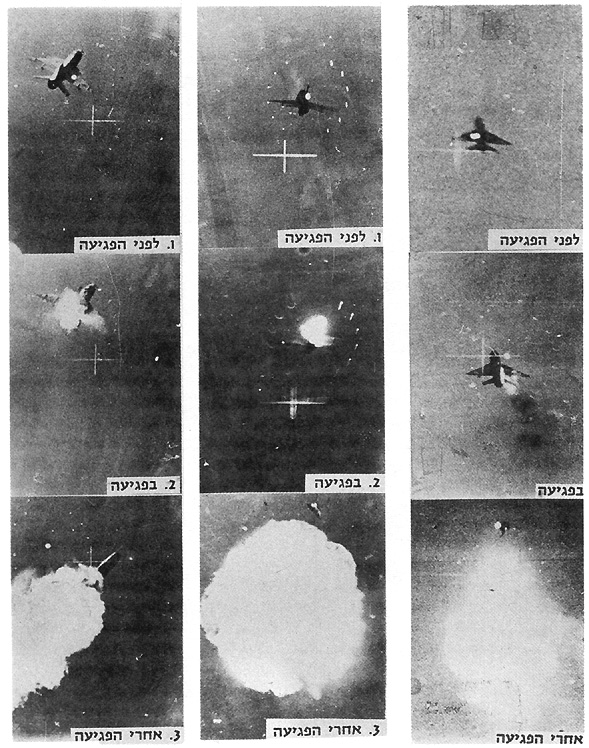
The IAF's French fighters, participants of the War for the Water.
From left to right: Dassault Mirage IIICJ, Dassault Mystere,
Sud-Ouest Vautour, Dassault Super Mystere & Dassault Ouragan.
Historical Background
The Israeli War of Independence ended in 1949 with Syrian control of land within mandatory Palestine, land which the UN, in its 1947 partition plan, had originally set aside for Israel. This enabled to Syrians to take a hard stance in their negotiations with the newborn state, and Syria was indeed Israel's last neighbor to sign an armistice agreement, on July 20th 1949. The armistice agreements, however, were only meant to serve as an interim solution to the Mid East conflict and were supposed to be followed by permanent peace agreements. This lead to the disputed lands being given a temporary status. The armistice agreements declared these as de-militarized zones, their future to be settled once permanent peace had been achieved. In the meanwhile, civilian life in the zones was to return to normal, without determining the final status of the disputed lands. Peace, however, did not come, and both sides interpreted "civilian life" as having quite different meanings. Syria sought to maintain the situation as it was when the armistice agreements were signed. Israel, on the other hand, saw it as its right to settle and develop these areas, a move seen by Syria as dictating the future of the territories.

The IAF's French fighters, participants of the War for the Water.
From left to right:
Dassault Mirage IIICJ, Dassault Mystere,
Sud-Ouest Vautour, Dassault Super Mystere & Dassault Ouragan.
April 7th 1967
The beginning of April 1967 saw Israel ready to resume cultivation of three plots near Kibbutz Ha'on, in the southern demilitarized zone, south of the Sea of Galilee. Although initially planned for April 3rd, bad weather prevented work from beginning on that date and it was delayed until April 7th. Israel, meanwhile, put the IDF on alert, fully aware that deterioration along the border was not unlikely. Tanks, artillery and mortars were moved into positions around the Sea of Galilee, while at various IAF bases aircraft were fuelled and armed for the day's possible combat. Search-and-Rescue helicopters, light observation aircraft and the IAF's command and control structure were put on alert as well, all in anticipation of events on the border.First two MiG kills
The attack was broken off however, when Syrian MiGs were spotted making their way towards the combat zone. The attacking aircraft were therefore pulled back and 101st "First Fighter" Squadron Mirages were vectored in to engage the new arrivals. The day's first two dogfights begun at 13:58 with Captains Iftah Spector & Benyamin Romah engaging a pair of MiG-21s over the Syrian town of Kuneitra. The high-speed approach between the two pairs soon turned into a tight twist and turn dogfight, the Israeli Mirages attempting to close in on the MiGs from behind. Spector was first to achieve this and downed one MiG after maneuvering slightly above his opponent and then sinking in for the kill. Romah however, found himself on a parallel course with the other fighter. Breaking toward the MiG at full throttle and with his afterburner, he managed to cut off his opponent and then approach him from the rear. Already over Damascus and pressured to turn back, Romah only managed a short burst from 400 meters away. This was sufficient for the kill, and the MiG was seen going down, exploding a few seconds later after taking hits from Spector's aircraft as well.
Number Three
By the time the shelling was over, another Syrian MiG had fallen prey to Israeli Mirages, this time from the 119th "Bat" Squadron. At 15:52 a dogfight took place between another pair of MiG-21s and two Mirages flown by Squadron leader Major Ran Peker and Captain Avraham Shalmon. Once again both pilots went after separate foes in dogfights that took them into Syrian territory. Peker's first Shafrir launch was a near miss, the missile's proximity fuse failing to detonate. The MiG pilot, upon spotting the missile, attempted to evade Peker by engaging his afterburner, the effect of which was actually providing Peker's second Shafrir with a near-perfect heat signature of the aircraft's engine. Peker however, in his eagerness, launched the missile out of envelope and the MiG managed to evade the missile. Now it was Peker's turn to engage his afterburner and close in for a cannon kill. A two seconds burst was sufficient to detonate one of the MiG's fuel tanks, turning the aircraft into a ball of fire. Shalmon meanwhile, was chasing the other MiG at full afterburner having jettisoned his underwing fuel tanks. From 1,000 meters away he fired his first Shafrir but the missile failed to hit its target. The second missile proved to be a miss as well, fired from 700 meters away. Shalmon then closed in to within 400 meters before firing his cannons. Although apparently hitting his opponent, he was directed to disengage. While the Mirages were making their way back to Tel-Nof, the stricken MiG made its way back to Syria's Dumayr air base.
The IAF's afternoon strikes ended at 16:16 and only six fighters remained on the scene, a pair from each Mirage squadron: the 101st, 117th & 119th. But while IAF aircraft were making their way back to base, four MiG-21s were taking off from Dumayr and making their way to the front at low altitude. The four MiGs aircraft appeared over the southern Golan Heights at 16:27, taking a route that took them from south to north over the frontier. By this time the two 117th Sqn. Mirages, flown by Major Ezra Dotan and Captain Avraham Lanir had teamed up with the 119th Sqn. aircraft, flown by Majors Mordechai Yeshurun and Oded Sagi, while the 101st Sqn. Mirages, flown by Captains Avner Slapak and Amnon Shamir, were patrolling elsewhere. At 16:30 ground control informed the six pilots of the enemy aircraft in their vicinity. The time of day was ideal for the Israeli pilots, with the afternoon sun at their backs, providing them with excellent visibility while blinding their opponents.Four, Five & Six
Ezra Dotan was first to spot the MiGs, west of Pik, a Syrian village near the Jordanian-Israeli-Syrian tri-border area. Spotting the Syrian formation's rear guard lagging behind the leading pair, Dotan and Lanir proceeded to take on the rear pair, Dotan taking on the formation's no 3. and Lanir engaging no. 4. An attempt by Dotan to launch one of his Shafrir failed and he was forced to chase his opponent at low altitude through the canyons of the Yarmouch, a tributary of the Jordan River. A burst of cannon fire from 400 meters away failed to hit the MiG and Dotan continued his pursuit to within 250 meters. A long burst from his cannon and the MiG went down, Dotan breaking westward to locate Lanir and the other Mirages. The Syrian pilot managed to parachute to safety, his aircraft crashing in Jordanian territory.
Lanir, meanwhile, was on the heels of his own opponent. Unlike Dotan, Lanir had jettisoned his underwing fuel tanks and had closed the distance between himself and the fleeing MiG-21 to within 200 meters. He had barely pressed the trigger when the MiG disintegrated into a ball of fire. Lanir's first bullets had apparently hit a fuel tank and the MiG had immediately detonated, without affording Lanir a change to break away. Lanir's Mirage flew right through the fireball created by the destroyed MiG, comprising of burning fuel alone by now and not of any debris, much to Lanir's good fortune (see picture below). The Mirage was scorched black however, including the canopy, effectively blinding its pilot. Escorted by Major Yeshurun, leader of the 119th Sqn. pair, Lanir managed to make his way back to Israel. The soot was soon swept away from the canopy and Lanir was able to bring his aircraft to a landing in Ramat-David AFB.
The two 101st Squadron Mirages flown by Slapak and Shamir had flown a separate patrol route from the other aircraft. Leading the pair, Captain Avner Slapak knew of other Mirages in the air but not of their number nor of their location. Upon spotting four
unidentified aircraft, Slapak turned to his ground control, inquiring whether any enemy aircraft were known to be in his vicinity. Despite receiving a negative answer, Slapak dismissed the possibility that the aircraft were Mirages and begun to give chase. He tried to inform others of his
actions but mistook the right radio frequency and could not get his message across. Soon the four MiGs split into
two pairs, the rear pair turning left and the leading pair right. Slapak begun chasing the rear pair, closing within 500 meters of one of the aircraft when he saw another Mirage descend on him from above! breaking away, Slapak went after the other MiG when once again the other Mirage got in his way. Despite his protests on the radio, he saw the other fighter open fire and down the MiG. As it turned out, Slapak had gone in after the same pair Lanir and Dotan had engaged, the interfering Mirage being none other than Dotan's.
Breaking away, Slapak suddenly noticed another MiG closing in on a Mirage, later identified once again as Dotan's. Having gone in after the MiG, Slapak was infuriated to see the other Mirage return to engage the MiG, getting in his way again. Descending lower to avoid a collision, Slapak engaged his afterburner and broke ahead of Dotan. Closing to within 250 meters, he fired his cannons and soon saw a number of small explosions rock the MiG, before a huge explosion totally destroyed the fighter. Turning away to team up with Shamir again, Slapak spotted a parachute descending away from the wreckage, and then the empty MiG crashing into the ground. Of the four MiG-21s, only one managed to make it back to Dumayr, all three others falling inside Jordan.

April 7th Kills, left to right: Dotan's, Lanir's, Slapak's.
Aftermath
The IAF had carried out 171 sorties during April 7th 1967, of which 84 were attack sorties and 52 were interception & patrol sorties (the remaining 35 were aircraft that were launched but did not get a chance to participate in the fighting). 17 Syrian targets were attacked, bombs dropped weighing a total of 65 tons. Israeli aircraft fired approximately 700 20mm rounds and 2,900 30mm rounds, 5 Shafrir AAM, one Matra 530 AAM and 93 T-10 rockets. The Syrian air force had carried out 28 MiG-21 sorties and 6 MiG-17 sorties, all patrol and interception sorties except for the four which had overflown Ein-Gev. Beginning at 14:40 the Syrians had also operated four helicopters on Search-and-Rescue missions to locate their downed pilots. Syria admitted the loss of four of its aircraft, three of them having gone down in Jordan while another was destroyed right over Damascus, in view of its public. Yet it claimed the destruction of 5 Israeli fighters and heralded the day as a Syrian victory. back to the IDF/AF page
back to the IDF/AF page